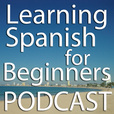
Summary: <br> This is Podcast 9, you can listen to it using the player shown above these lines.<br> In this audio lesson we will learn 5 Important verbs in Spanish.<br> You can find the transcript of this lesson in the following lines:<br> <br> Downloadable PDF Transcript: Download here<br> <br> Podcast Transcript (Text Version):<br> <br> Hi, welcome to Learning Spanish for Beginners, the place to learn Mexico’s conversational Spanish.<br> <br> Today we will review 5 important verbs in Spanish, as well as a few sentences that use them.<br> <br> <br> The first verb is “ser”, it means “to be” and it is used to refer to permanent or essential characteristics.<br> <br> For example,<br> I am a man – Soy un hombre.<br> I am intelligent – Soy inteligente.<br> I am a human being – Soy un ser humano.<br> <br> <br> The second verb of today is “estar” which also means “to be”. It is used to refer to temporary or nonessential characteristics.<br> <br> For example,<br> I am tired – Estoy cansado<br> I am at the office – Estoy en la oficina<br> I am happy – Estoy contento<br> <br> <br> The third verb of today is “tener”. It means “to have” in the sense of owning or possessing something.<br> <br> A few examples are,<br> I have twenty dollars – tengo veinte dólares<br> I have a sister – Tengo una hermana<br> I have to go – Tengo que ir <br> <br> <br> As a note,<br> “Tengo que + a verb in infinitive” is a useful phrase to talk about an obligation or a need to do something.<br> <br> For example,<br> <br> I have to eat more vegetables – Tengo que comer más vegetales <br> I have to talk to my teacher – Tengo que hablar con mi maestro<br> I have to go to the bathroom – Tengo que ir al baño<br> <br> <br> The fourth verb we will look at is “haber”.<br> <br> This verbs is often used as an auxiliary in phrases like:<br> <br> I have found the keys – He encontrado las llaves<br> <br> Or something like:<br> Have you looked for the keys? - Has buscado las llaves?<br> <br> “Haber” is also commonly used in Spanish to say “there is” or “there are”.<br> <br> For example,<br> There is no problem – No hay problema<br> or something like:<br> There are many options – Hay muchas opciones<br> <br> Another common use of “haber”, is in phrases that have the structure:<br> “Hay que” + “a verb in infinitive”<br> This phrase is used to express the need to do something.<br> <br> For example,<br> Hay que comer – It is necessary to eat<br> Hay que trabajar – It is necesssry to work<br> <br> <br> It is easy to remember the verb “haber” because it looks very similar to the verb “to have” in English.<br> <br> All you have to do is change the letter “v” for a “b” and add the letter “r” at the end.<br> <br> So you go from “have” to “haber”.<br> <br> <br> The last verb of today is “querer”, which means “to want”, and in some contexts, it also means “to love”.<br> <br> Let’s look at a few examples,<br> <br> I want water – Yo quiero agua<br> I want food – Yo quiero comida<br> I love my family – Yo quiero a mi familia<br> <br> The verb “querer” + “a verb in infinitive” are often used to express the desire or a need to do something as well.<br> <br> For example,<br> <br> I want to sleep – Quiero dormir<br> I want to eat – Quiero comer<br> I want to drink water – Quiero tomar agua<br> I want to drink beer – Quiero tomar cerveza<br> I want to go home – Quiero ir a casa<br> I want to go to my hotel – Quiero ir a mi hotel<br> <br> <br> That’s all for today.<br> To learn more Spanish and to access a downloadable text version of this audio, you can visit the Podcast section at LearningSpanishForBeginners.com<br> See you next time,
